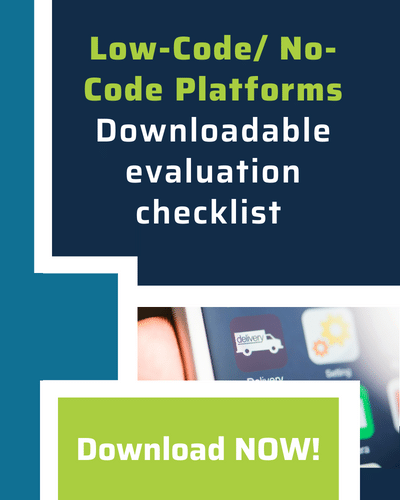Now more than ever, enterprises are turning to automation to help them economize while still meeting the evolving challenges of the market. These challenges may include the hiring freezes that accompany a recession, tightening budgets due to a soft economy, and an ongoing talent shortage. All these elements make it harder for enterprises, especially those with complicated ERP environments, to automate their business processes and take advantage of the full benefits of modern cloud-based infrastructures.
Historically, enterprises have looked at RPA, or robotic process automation, as the de facto tool to automate existing digital processes. It has always played a strong role in this process, since it allows companies to automate repetitive elements of a business process, reducing human error and increasing consistency and efficiency.
However, organizations are beginning to realize that RPA has its limitations. It needs to be constantly updated when processes change or systems are upgraded. Moreover, RPA is not only limited to the automation of existing digital assets, but in some cases, it simply masks certain inefficiencies that become apparent in other areas of the automation process. Organizations are now realizing that RPA is only one portion of the puzzle when it comes to leveraging automation in these complex enterprise and ERP landscapes.
Given the current state of market uncertainty, smart organizations are looking to identify these areas of inefficiency, finding the gaps in their business processes in order to digitize and more effectively automate those processes. Since this is an ongoing effort, enterprises need an efficient and scalable way to implement automation across the organization. This is the first step to improving performance.
Today organizations need to use two additional resources toward this goal: process mining, and low-code/no-code tools. These should be stitched together with RPA to automate processes across the enterprise, at scale.
Process Mining: Once (or while) the existing digital assets are automated using RPA, the organization needs to identify both inefficiencies and the gaps that occur across their business processes. These so-called gaps may currently be “bridged” by cumbersome manual processes, paperwork, spreadsheets, email communications, and so on.
An effective enterprise process mining tool can analyze how a business application truly functions within an enterprise–not how the process chart or the supposed experts say it should function. Process mining provides a real-time view of how processes are executed on the ground, across departments, across geographies, across lines of business, and so on. It gives a visual representation of inefficiencies, discrepancies, and potential areas of improvement.
Once the organization has a realistic view of its current processes, the next step is to fix them. Correction and optimization can be achieved in many ways in an ERP environment, from system configuration or improved data management, to the use of other applications that manage the enterprise organization. Gaps and inefficiencies are often inherent in legacy applications and processes, including tasks that workers have to conduct manually, like printouts or emails. This is where a low-code/no-code comes in.
Low-Code/No-Code (LC/NC). The creation of new applications is the bedrock of innovation. Application development addresses the replacement of old, legacy systems and/or the digitization of manual processes. New applications will always need to be integrated into existing ones to address business process continuity, data flow, roles, authorizations, and so on. Low-code/no-code tools simply facilitate the automation of this “creation” process, which involves building the actual “bridges” of code to address these gaps.
An enterprise low-code/no-code tool should have these three basic capabilities:
-
Application creation: LC/NC platforms should provide the tools to easily create different applications for various platforms and end-devices like web-based and mobile, without having to write extensive code in a particular programming language.
-
Enterprise integration: Enterprise applications are rarely siloed; they need to automatically integrate with other applications. In a complex environment, LC/NC tool will need to have pre-built integrations with ERP systems like SAP and Oracle; and CRM solutions like Salesforce. Processes for inventory management, supply-chain, vendor management, and many other systems must work seamlessly together in the same environment. These integrations not only address business rules and data flow but must also include enterprise authentications, roles, and authorizations as per the organization’s security policy.
-
DevOps: Development Operations is another area where enterprise automation becomes critical. If a company has to use manual labor to provision servers and manage their infrastructure, it defeats much of the purpose of automating their application development and integrations. A sophisticated enterprise low-code/no-code platform will automate the DevOps portion of a company’s application management, including their infrastructure provisioning and the management of the underlying infrastructure.
Low-code/no-code can be a unifying factor, providing more seamless functionality between individual automations or functionslike CRM, inventory management, finance, procurement functions, and so on. It can also serve as the “last mile” that blends automation with human experience to create a user-friendly, functional, and efficient interface, one that accommodates the human factor amongst all the robotics and programming. It allows developers to focus on the more intricate processes that create an intuitive worker-facing GUI, empowering employees to deliver a satisfying customer experience. These unifying software blocks are critical in allowing personnel—from cross-country drivers to customer service reps, to human resources people and more—to best leverage their departmental software.
They say that application development is the cradle of innovation. However, low-code/low code is the methodology that automates this cradle of innovation, allowing developers to design ideal, unified business processes across enterprise environments of the future.
Full article copy can be seen here on page #34 (19 of pdf), or download it here



 Back
Back/Logo%20-%20black%20text%20blue%20pillar%20(large)-1.jpg)

